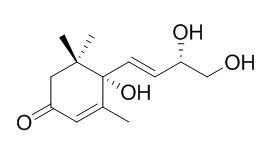Cucumegastigmane I
Standard reference
Inquire / Order:
manager@chemfaces.com
Technical Inquiries:
service@chemfaces.com
Tel:
+86-27-84237783
Fax:
+86-27-84254680
Address:
1 Building, No. 83, CheCheng Rd., Wuhan Economic and Technological Development Zone, Wuhan, Hubei 430056, PRC
Providing storage is as stated on the product vial and the vial is kept tightly sealed, the product can be stored for up to
24 months(2-8C).
Wherever possible, you should prepare and use solutions on the same day. However, if you need to make up stock solutions in advance, we recommend that you store the solution as aliquots in tightly sealed vials at -20C. Generally, these will be useable for up to two weeks. Before use, and prior to opening the vial we recommend that you allow your product to equilibrate to room temperature for at least 1 hour.
Need more advice on solubility, usage and handling? Please email to: service@chemfaces.com
The packaging of the product may have turned upside down during transportation, resulting in the natural compounds adhering to the neck or cap of the vial. take the vial out of its packaging and gently shake to let the compounds fall to the bottom of the vial. for liquid products, centrifuge at 200-500 RPM to gather the liquid at the bottom of the vial. try to avoid loss or contamination during handling.
Foods.2020, 9(10):1348.
Plants (Basel).2023, 12(11):2107.
J Agric Food Chem.2024, 72(15):8784-8797.
Expert Opin Ther Targets.2024, :1-11.
Korean J Dent Mater.2018, 45(2):139-146
Front Plant Sci.2021, 12:673337.
PLoS One.2020, 15(2):e0220084.
Biomolecules.2023, 13(2):227.
Molecules.2020, 25(11):2599.
Phytother Res.2019, 33(4):1104-1113
Related and Featured Products
Apocynol A
Catalog No: CFN97750
CAS No: 358721-33-2
Price: Inquiry(manager@chemfaces.com)
Megastigm-7-ene-3,5,6,9-tetraol
Catalog No: CFN98335
CAS No: 680617-50-9
Price: Inquiry(manager@chemfaces.com)
7-Megastigmene-3,5,6,9-tetraol
Catalog No: CFN98334
CAS No: 276870-26-9
Price: Inquiry(manager@chemfaces.com)
Euscaphin B
Catalog No: CFN97536
CAS No: 956869-95-7
Price: Inquiry(manager@chemfaces.com)
Megastigm-7-ene-3,4,6,9-tetrol
Catalog No: CFN96244
CAS No: 180164-14-1
Price: Inquiry(manager@chemfaces.com)
cis-3,4-Dihydroxy-beta-ionone
Catalog No: CFN96404
CAS No: 875666-39-0
Price: Inquiry(manager@chemfaces.com)
Ascleposide E
Catalog No: CFN98414
CAS No: 325686-49-5
Price: Inquiry(manager@chemfaces.com)
Citroside A
Catalog No: CFN96992
CAS No: 120330-44-1
Price: Inquiry(manager@chemfaces.com)
Icariside B1
Catalog No: CFN96968
CAS No: 109062-00-2
Price: Inquiry(manager@chemfaces.com)
Dihydrophaseic acid
Catalog No: CFN98657
CAS No: 41756-77-8
Price: Inquiry(manager@chemfaces.com)
Pharm Biol. 2015 Nov;53(11):1602-7.
Chemical constituents of the Annona glabra fruit and their cytotoxic activity.[Pubmed:
25856711]
METHODS AND RESULTS:
One new, (2E,4E,1'R,3'S,5'R,6'S)-dihydrophaseic acid 1,3'-di-O-β-d-glucopyranoside, and eight known compounds, (2E,4E,1'R,3'S,5'R,6'S)-dihydrophaseic acid 3'-O-β-d-glucopyranoside (2), icariside D2 (3), icariside D2 6'-O-β-d-xylopyranoside (4), 3,4-dimethoxyphenyl O-β-d-glucopyranoside (5), 3,4-dihydroxybenzoic acid (6), blumenol A (7), Cucumegastigmane I (8), and icariside B1 (9), were isolated from the fruits of A. glabra.
CONCLUSIONS:
Icariside D2 (3) was found to show significant cytotoxic activity on the HL-60 cell line with the IC50 value of 9.0 ± 1.0 µM and did not show cytotoxic activity on the Hel-299 normal cell line.
Fitoterapia. 2013 Jan;84:227-36.
Phytochemical and therapeutic potential of cucumber.[Pubmed:
23098877]
The fruit is refrigerant, haemostatic, tonic and useful in hyperdipsia, thermoplegia etc. The seeds also have a cooling effect on the body and they are used to prevent constipation.
METHODS AND RESULTS:
Several bioactive compounds have been isolated from cucumber including cucurbitacins, Cucumegastigmane I and Cucumegastigmane II, cucumerin A and B, vitexin, orientin, isoscoparin 2″-O-(6‴-(E)-p-coumaroyl) glucoside, apigenin 7-O-(6″-O-p-coumaroylglucoside) etc. Despite huge exploration of cucumber in agricultural field, comparatively very few studies have been published about its chemical profile and its therapeutic potential. This article reviews the therapeutic application, pharmacological and phytochemical profile of different parts of C. sativus.
CONCLUSIONS:
In this review we have explored the current phytochemical and pharmacological knowledge available with this well known plant and several promising aspects for research on cucumber.



